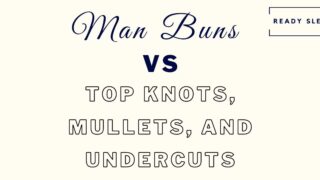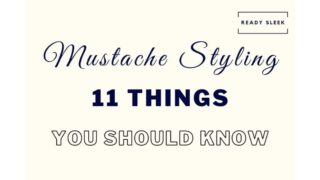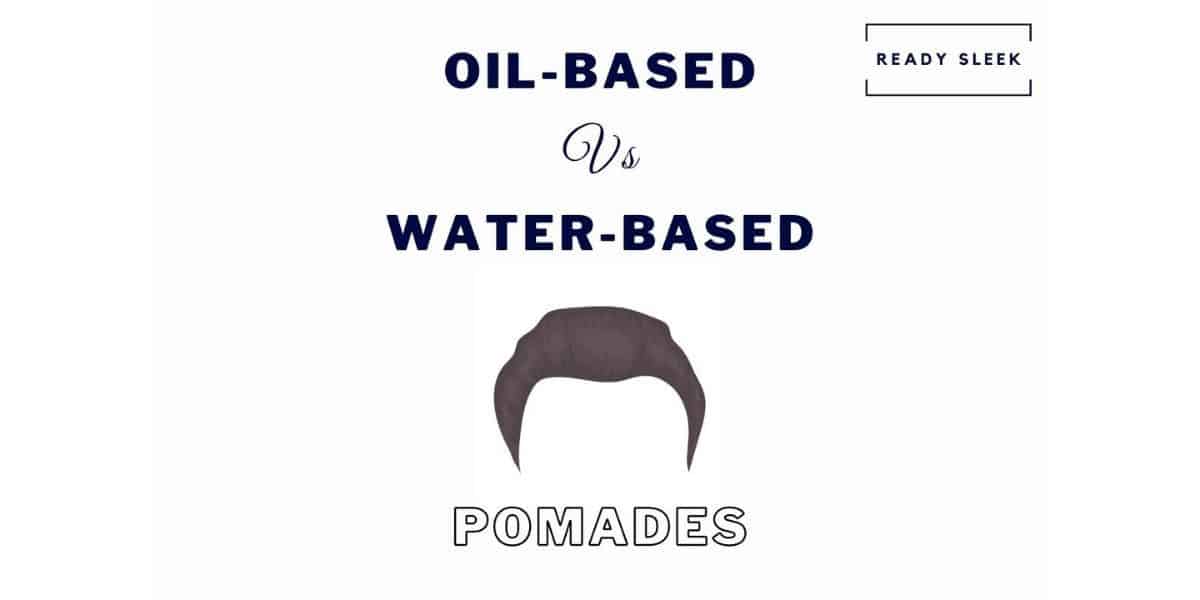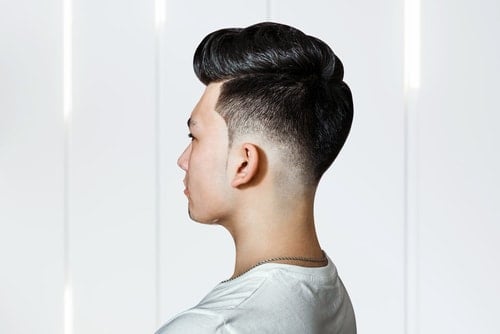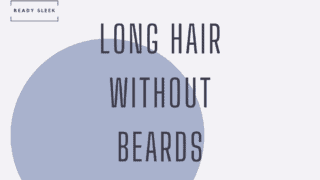It’s the side profile that does it for me. Seeing the top of your head looking as flat as a plank in a photograph is infuriating. Here are some fixes every flat-haired man should know.
Let’s get to it.
11 Ways To Fix Flat Hair (For Guys)
The great thing is – there are many fixes.
The not-so-great thing? Not all of them work for you.
Every man’s hair is different. So experiment with these solutions regularly to find ones that work for you.
1. Get A Layered Haircut
It all starts here.
Trying to add volume to a haircut that naturally falls flat is like trying to fill a bathtub with the drain unplugged.
It’s a losing battle.
If the hair on top likes to naturally fall flat, there’s a good chance it doesn’t have enough layering.
Layering is produced by cutting the strands of hair to various different lengths and literally arranging the hair into layers.
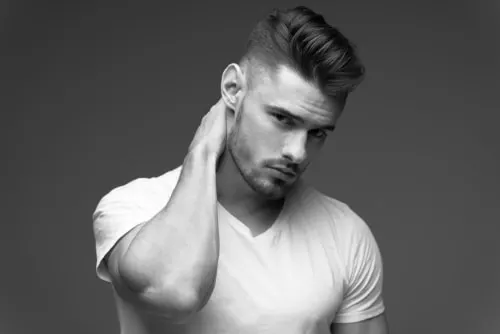
The top layers are cut shorter than the layers beneath them.
Layering produces an effect where the hairs prop each other up, almost creating a support structure that makes it less likely for them to fall flat.
It makes it much easier to build texture, volume, movement, and fullness – even without hair products.
So, the first step you should take is speaking to your barber. Explain that your hair keeps falling flat and you want a layered haircut that’ll allow you to build volume quickly and painlessly.
Once you’ve got that, the rest of the tips you’re about to read are a lot more likely to work.
2. Degrease It
Greasy hair is more likely to fall flat than washed hair. It really is as simple as that.
When you think about it, dirt, oil, grease, grime – it all adds weight. This additional weight is more than likely to cause it to fall flat even after trying every other trick in the book.
So, wash it before attempting to style it – even if it’s just with water alone.
Shampoo would be preferable. A good volumizing shampoo should gently cleanse without getting rid of too much moisture.
John Frieda’s Volume Lift (Amazon Link) is a good example.
Work it into the roots with the tips of your fingers before thoroughly rinsing it off.
Shampoo can be drying, so using it 2-3 times per week would be better than using it every day.
It’ll cleanse it, removing grime and weight from the hair and making it less likely to flop flat after styling it.
But a volumizing shampoo will also add some fullness in its own right.
What about conditioner though?
That one’s not as simple…
3. Avoid Using Too Much Conditioner
In fact, if you’re finding that your hair keeps falling flat, you’d probably be better off not using any conditioner at all.
This may sound strange. Hair conditioners usually make people think of fullness, lift, and the opposite of flatness.
But the truth is that conditioner has its benefits for a lot of people, but probably works against the objectives of many others.
It makes the hair silky, smooth, and soft. Silky and soft hair feels great to touch but is often harder to style.
It’s easier to build texture and volume when the hair has just the right amount of grit to it. It’ll be more likely to stay in place after you’ve styled it.
Very silky hair, however, is way more likely to fall back down.
Using a good volumizing shampoo alone should be enough for most men. It’ll leave it feeling soft, but not too soft.
If you really want to use a conditioner, use the minimum amount. Don’t overdo it. There’s a good chance it’s destroying your other anti-flat efforts.
4. Sea Salt Spray
Sea salt spray adds grit.
Not too much – just the right amount.
Think of that beach-soaked, windswept hair that just seems to stay in place no matter how you style it.
Texture, volume, lift, strand separation. It just refuses to fall flat.
Sea salt spray can do that. It absorbs our natural oils in order to do it.
No two sea salt sprays are the same. Some might have features that other sprays don’t – for example, Vitamin E, aloe, UV protection, etc.
Some even include ultra-beachy stuff like algae and seaweed.
It’s best to apply it before the hair completely dries. It’ll create texture as it does dry and also make it more responsive.
Blow-drying the hair after applying the sea salt spray will help you to build even more volume with it. I’ll be talking about blow-drying in more detail a bit later.
Air-drying sea salt spray will still make it more responsive, adding grit and making it less likely to fall flat. It just won’t be as effective as blow-drying it afterward.
5. Experiment With Volumizing Pre-Stylers
Sea salt spray is one option. If you use that, you really won’t need to use much else.
But there are many other pre-stylers with all sorts of functions that you could experiment with.
Some of them reduce frizz, while others smoothen. When you’re having trouble with hair falling flat, your best bet would be using a volumizing pre-styler that’ll add volume.
Again – it’ll add fullness and volume when applied before the hair dries.
I use a blow-dry spray by John Frieda (Amazon Link), but there are plenty of others to choose from.

Mousses work well as volumizing pre-stylers, such as this one (Amazon Link) by OGX. They produce a light and airy finish that’s easy to build texture with while styling.
Pre-stylers won’t be for everyone.
After all, it adds another step into your grooming routine. If you’re a minimalist with your routine or simply don’t have much time to get ready in the morning, this may not be ideal.
But a few spritzes of pre-styler before you blow-dry really doesn’t take much time.
If you didn’t want to shell out for anything too expensive, there are some affordable sea salt sprays out there that should do the trick.
Try it out – you’ll probably never go back.
6. Blow Dry – Target The Roots
Blow-drying is one of the pillars of volume-building. It just makes sense.
Use pressure and heat to lift the hair and make it stay that way for longer than it otherwise would.
It makes it so much easier to build volume into your hair, especially after using a volumizing pre-styler.
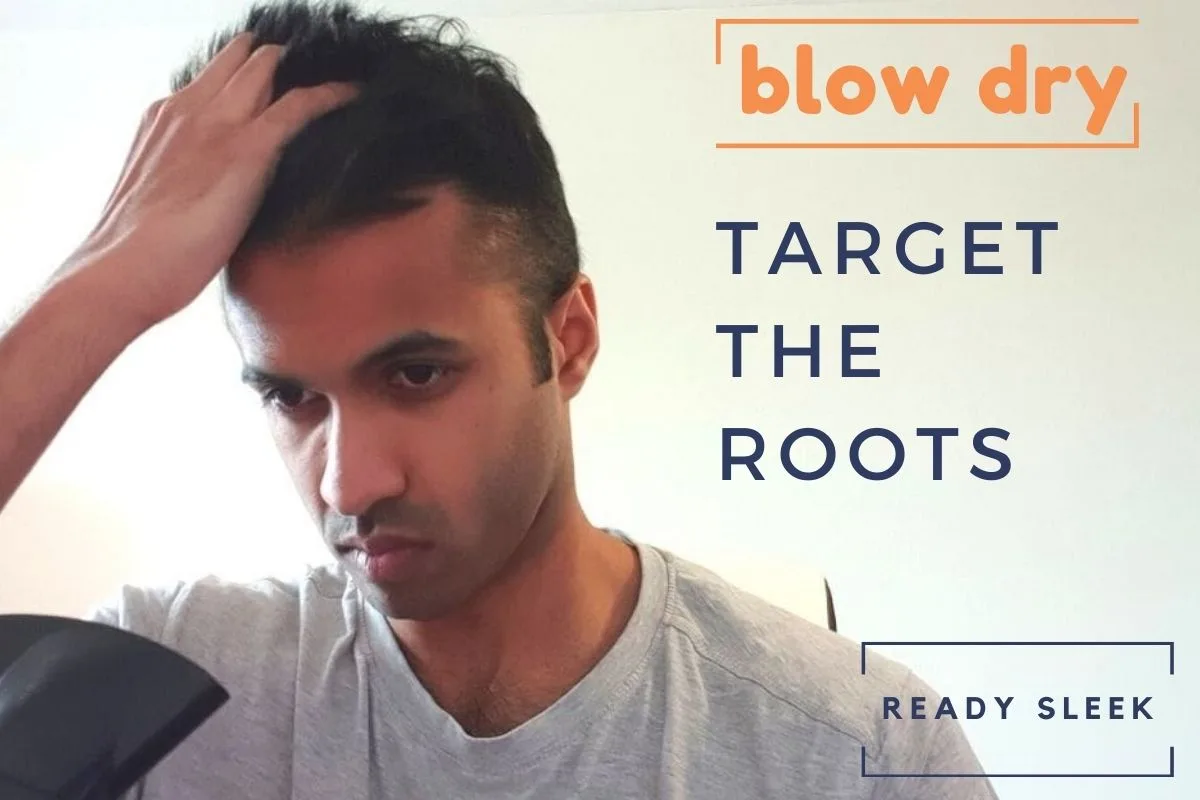
But men often make the mistake of simply blow-drying the tips. They don’t target that pressure and heat down at the roots.
The roots are where that lift will originate from – not the tips. So, focus the pressure from the blow-dryer here to really see long-lasting volume.
A concentrator nozzle is an attachment you pop onto the end of a blow-dryer. It allows you to focus (i.e concentrate) the pressure and heat into narrow areas of hair. You can see one in the photo of me above.
This gives you a lot more control and precision.
This will allow you to build volume (or reduce volume) using a blow-dryer only in the specific areas you want to.
Be careful with it though. Excessive pressure and heat is definitely not good for the hair. Use a medium-heat setting at a maximum and go for a medium-to-high speed setting.
This should be more than enough.
Also, try and look for a pre-styler with heat protectant included.
Don’t be afraid to blow-dry in different directions – that’ll really give you some fullness. Left, right, forward, back – before eventually finishing off by blow-drying in the direction you want your final style to be in.
7. Finger Tousle Like A Pro
Never underestimate just how perfect human fingers are for building texture and layering into hair.
It’s like they were designed for that sole purpose.
It’s something you’ll get better at over time. But whether it’s while blow-drying or while applying styling products, use your fingers to tousle and cup the hair to build volume and fight against flat hair.
I find that finger tousling while blow-drying is very effective. It prevents the hair from exploding into a lion’s mane appearance after being blow-dried at the roots.
It allows the blow-dryer to build volume while still creating great texture and strand separation.
It’s important to finger tousle without causing the hair to form clumps. You want a light touch while finger tousling – that’s what will create that light and airy finish.
Experimentation is the key to finding the exact tousle technique that gives you the finish you want.
8. Try A Round Brush
If finger tousling produces too much texture or strand separation for you, a round brush may be a better option.
Using a round brush, especially while blow-drying, will produce a wavier finish with flips and gentle curls.
It’ll also produce incredible volume, usually even more than using your fingers would. I use a round brush for high-volume quiffs sometimes – they’re great for those.
Using a round brush with a blow dryer can be tricky to get used to at first.
Gently wrap (twist) sections of hair around the round brush and lock it into place using some pressure and heat from a blow-dryer with a concentrator nozzle on. Then, gently unwrap, being careful not to tug or pull too hard.
You’ll be left with a voluminous, wavy finish that’s hard to compete with. A round brush could be the flat hair antidote that you’ve been looking for.
9. Style Against The Grain
The “grain” is the direction in which your hair grows. As you can imagine, your hair grows in many different directions in many different parts.
Because of this, the “grain” will be different depending on which part of the hair you’re styling.
On the top, the general direction of growth will be forward and one side or the other. Knowing where your hair parting is will be important here.
As a general rule, if you want to flatten hair, lay it down in the direction it grows. If, however, you want to fix flat hair and make it spring up, style it in the opposite direction to which it grows.
Here’s an example.
Let’s say you’ve got a left side parting and your hair naturally falls forward and to the right. If you wanted a nice, slick, and flat style, you’d simply style it in the direction it grew – to the right.
There’s a good chance it would stay that way.
But if you want to fight against flatness and really build volume, you’d be better off styling it against the direction it naturally likes to lie in.
In this case, that’s toward the left.
So, if you find that your hair keeps falling flat, try styling it in a different direction. More specifically, try styling against its preferred direction.
There’s a good chance you’ll find it a lot easier to build volume that way.
10. Avoid Oily And Shiny Products
Of course, hair oils would fall into this category. But these aren’t all that popular with men in any case.
The main culprits are oil-based hair products. These are heavy, weighing the hair down and causing it to fall flat.
They’re also shiny, which generally lends itself to a slicker, glossier, and more defined style. It isn’t great for building texture and volume with. When you’re trying to fight flat hair, this isn’t ideal.
Oil-based hair products include oil-based pomades and hair waxes. In general, they’re not great for building volume.
A glossy pompadour or an impeccable slick back? Definitely.
But not for styles where you’re looking to build volume.
It isn’t just oil-based products you should avoid in these instances. Water-based products like water-based pomades and hair gels should also be avoided.
They’re also much better suited to slick, defined, and flat hairstyles. They aren’t as heavy as oil-based products, but they’re definitely not great for building texture and volume with.
11. Clays, Pastes, And Creams
Now we’re talking.
When you’re looking to build fullness and texture and to correct that flat hair, go for matte or low-shine products.
They’ll allow you to use your fingers or a round brush in a way that doesn’t cause the hair to flatten or clump together.
Instead, you’ll be able to build layering and strand separation with ease. Remember – layers are crucial when you’re combating flatness.
The type of low-shine product you choose should mainly depend on how much hold you want.
Clays are popular for being a low shine product with a typically heavy hold, thanks to the grit you get from the clay minerals. These are usually bentonite or kaolin.
Pastes are usually (but not always) a step lower than clays when it comes to hold. It usually has a smoother consistency and is less gritty than clay.
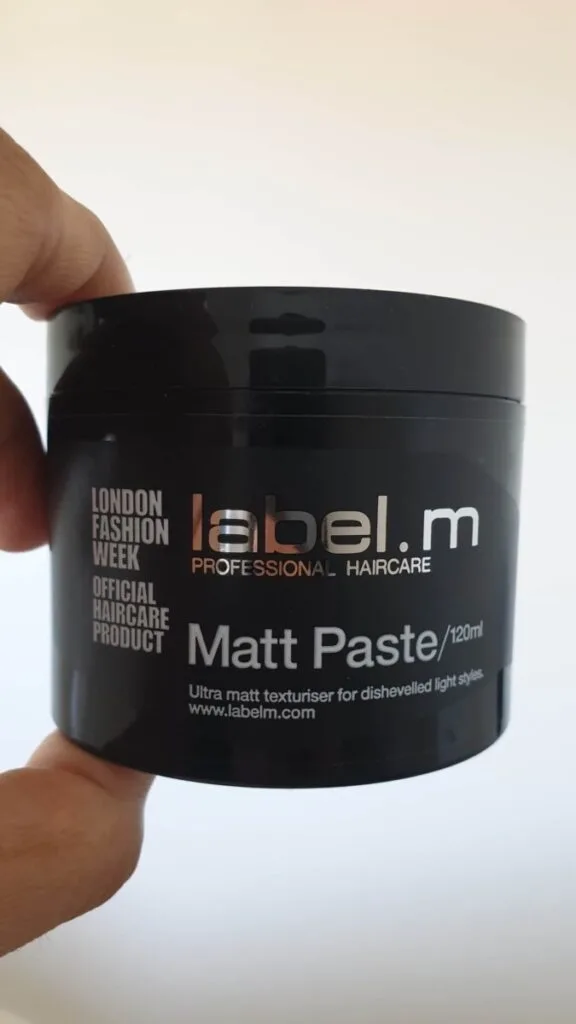
But it often produces a medium hold that’s easy to work with. They’re usually matte or low shine and are easy to build volume with.
Hair creams have an even smoother consistency, break down very easily, and spread through the hair like a dream. I usually find the hold on creams to be even lighter than pastes – not strong enough for the more gravity-defying styles.
But they’re usually pretty low shine and good for thin-haired men looking to build some fullness.
The beauty of all of these products is that the hold they produce is pliable. In other words, they don’t dry stiff.
This means you can restyle it during the course of the day without having to add any moisture.
So, if you notice that some of your hair has fallen flat in the afternoon, a quick finger tousle should allow you to set it back in place (to an extent).
Conclusion
As I mentioned, you’ll need to experiment with these and find the techniques that really do it for you.
Flat hair can be frustrating, but the cause behind why it’s happening to you is often easy to find.
Once you’ve figured out why it’s happening, the right solutions should be even easier to find.
Enjoy.
Ready Sleek founder. Obsessed with casual style and the minimalist approach to building a highly functional wardrobe. Also a fan of classic, vintage hairstyles.

![11 Quick And Easy Ways To Fix Flat Hair [Men’s Guide]](https://www.readysleek.com/wp-content/uploads/2021/07/how-to-fix-flat-hair-featured-image-720x405.jpeg)

